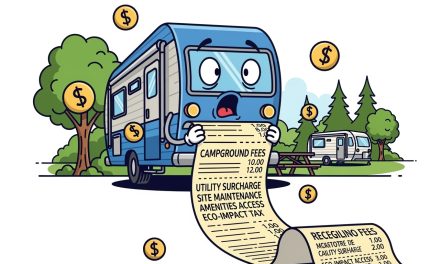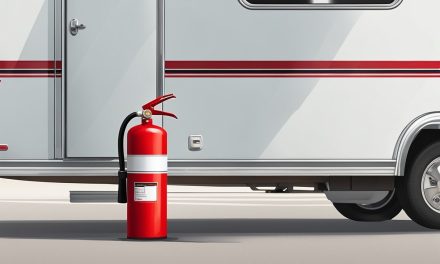Would you like to save this article?
Dreaming of hitting the road in an RV but worried about your loan approval? Many lenders look for a credit score of 680 or higher to qualify. This guide breaks down the steps to boost your chances, from checking your credit report to saving for a down payment.
Keep reading to learn how you can secure that RV loan.
What Are the Requirements for an RV Loan?
Getting approved for an RV loan depends on your credit score, income, and debt—lenders look for solid financial footing. You’ll typically need a down payment (often 10%-20%) and proof of stable earnings to qualify.
Minimum credit score
Most RV lenders require a minimum credit score of 600 to qualify for a loan. Scores in the high 500s might get approved, but expect higher interest rates.
For the best rates, aim for a credit score between 700-800. If your score is below 680, lenders may cap your loan amount at $50,000 or require a larger down payment. Bad credit loans exist—some lenders, like GreatRVLoan, accept scores as low as 550, though APR jumps to 9.99%-19.95%.
Check your credit report before applying to avoid surprises.
Proof of income
Lenders need proof of income to confirm you can handle monthly payments on an RV loan. They’ll ask for recent pay stubs, tax returns, or bank statements—anything showing steady earnings.
Self-employed borrowers might need profit-and-loss statements or 1099 forms.
Your debt-to-income (DTI) ratio matters too. Lenders divide your monthly debts—like mortgage, car loans, and credit card payments—by your gross income. For example, $1,300 in debts with a $4,000 income gives a 32.5% DTI.
A lower DTI boosts approval odds. Next up: how your debt-to-income ratio affects RV loan eligibility.
Income proof isn’t just paperwork—it’s your financial story in numbers.
Debt-to-income ratio
Your debt-to-income (DTI) ratio plays a big role in RV loan approval. It shows how much of your monthly income goes toward debts like credit cards, auto loans, or home mortgages. Lenders prefer a DTI below 43% – but lower is better for qualifying.
Adding an RV payment can push your DTI higher. For example, a $240 monthly payment could raise it from 32.5% to 38.5%. Keep revolving debt low and pay down existing loans to improve your borrowing capacity before applying.
Some lenders may accept slightly higher ratios for secured loans using the RV as collateral.
Down payment
Saving for a down payment is a key step in qualifying for an RV loan. Most lenders require 10-20% upfront—so for a $75,000 RV, expect to pay $7,500-$15,000. Your credit score plays a big role—excellent credit might only need $7,000 down on a $70,000 loan, while lower scores could mean $14,000 or more.
Some lenders like Trident Funding offer zero down options for loans up to $70,000, but these are rare. A larger down payment reduces your loan-to-value ratio, which can help secure better terms.
Plan ahead and save—it’ll lower your monthly payments and interest rates.
How to Qualify for an RV Loan
Want to get an RV loan? Start by checking your credit score, saving for a down payment, and gathering income documents—then keep reading to learn the next steps.
Check your credit score
Your credit score plays big role when applying—for RV loans. Lenders rely on this number—to decide approval—and set interest rates based on risk levels linked back directly through past behaviors recorded within each individual file stored at major institutions like TransUnion among others listed under official sources such as AnnualCreditReport.com where free copies get pulled annually without hassle involved whatsoever!
*“Know where you stand before stepping into any lender’s office.”*
Pull reports early since errors happen sometimes dragging scores down unfairly over time due simply because nobody caught mistakes earlier.
Improve your credit, if needed
A good credit score helps you qualify for better RV loan rates. If your credit needs work, follow these steps to boost it before applying.
- Check your credit reports from all three credit bureaus—Equifax, Experian, and TransUnion. Look for errors that could hurt your FICO score.
- Pay all bills on time, including credit cards and student loans. Late payments can drag down your score.
- Keep credit card balances below 30% of your limit. Lower is even better—aim for 25% to maximize your score.
- Avoid closing old credit cards, even if you don’t use them. A longer credit history improves your rating.
- Set up automatic payments to ensure you never miss a due date for loans or revolving credit accounts.
- Request a credit limit increase on existing cards. This lowers your credit utilization ratio without new debt.
- Maintain a mix of installment loans (like personal loans) and revolving credit (like credit cards). Lenders prefer balanced credit histories.
- Dispute inaccuracies on your credit reports promptly. Errors can unfairly lower your score and hurt loan approval chances.
- Use a credit score worksheet to track progress over time. Regular checks help spot trends early.
- Pay down high-interest debt first, especially before applying for an RV loan. A lower debt-to-income ratio increases approval odds.
Save for a down payment
After improving your credit score, the next step is saving for a down payment. A solid down payment can lower your loan amount and boost approval odds.
- Aim for 10-20% down as the standard for most RV loans—this reduces your principal and interest payments.
- Borrowers with lower credit scores may need a higher down payment, sometimes up to 30%, to qualify.
- Some lenders, like Trident Funding, offer zero down for loans up to $70,000, but these deals are rare.
- Use an RV loan calculator to estimate monthly payments based on different downpayment amounts.
- Consider second mortgages or home equity loans as alternatives if cash is tight—but watch for refinancing risks.
- Cutting expenses like campground trips or unused subscriptions can free up funds faster for your downpayment.
- Avoid tapping into savings with high liquidity needs, like emergency funds or retirement accounts.
- Check for discounts from dealers—some offer lower rates or incentives for larger down payments.
- Save any lump sums, such as tax refunds or bonuses, toward your RV downpayment goal.
- Compare terms from banks, credit unions like Space Coast Credit Union, and online lenders for the best repayment options.
Gather necessary documents
Once you’ve saved for a down payment, it’s time to collect the paperwork needed for your RV loan. Lenders require specific documents to verify your identity, income, and financial stability.
- Social Security number – You’ll need to provide your SSN for credit checks and loan approval.
- Driver’s license – A valid ID confirms your identity and matches the information on your loan application.
- Proof of income – Recent pay stubs, tax returns, or bank statements show you can afford the loan payments.
- Employment details – Lender may ask for contact info from your employer to confirm your job status.
- Debt records – Credit card bills, student loans, or other debts help calculate your debt-to-income ratio.
- Vehicle identification number (VIN) – Required if you’re buying a specific RV or travel trailer.
- Bank account info – Checking or savings details may be requested for direct payments or verification.
Having these documents ready speeds up the loan process and improves approval chances.
Can You Get an RV Loan with Bad Credit?
Getting an RV loan with bad credit is tough, but some lenders specialize in low credit scores. You might need a bigger down payment or a co-signer—options like subprime lenders and credit unions can help.
Used RVs and shorter loan terms may improve your chances, but expect higher APRs… Compare offers carefully to avoid predatory rates.
Qualifying with a low credit score
Getting an RV loan with bad credit isn’t impossible—some lenders approve scores as low as 550. Expect stricter terms, like higher APRs (up to 19.95%) and lower loan caps (max $50,000 for scores under 680).
Your debt-to-income ratio and down payment can offset weak credit, but shop around for specialized lenders like GreatRVLoan or iNet.
*A low credit score doesn’t mean you’re out of options. It just means you’ll pay more for the privilege of hitting the road.*
Bad credit borrowers often face shorter loan terms and heftier interest rates. Focus on improving your credit score before applying, or explore secured loans using the RV as collateral.
Co-signers and larger down payments also boost approval odds. Keep an eye on loan-to-value ratios—they’re critical for lenders assessing risk.
Best RV lenders for bad credit
Finding an RV loan with bad credit isn’t impossible—some lenders specialize in lower credit scores.
| Lender | Min. Credit Score | APR Range | Loan Amount | Term Length | Down Payment | Other Details |
|---|---|---|---|---|---|---|
| GreatRVLoan | 550 | 9.99%–19.95% | $10k–$75k | 60–240 months | 10% | N/A |
| iNet | 550 | 6.24% | $5k–$1M | Up to 240 months | Varies | Private party & dealer loans |
| Southeast Financial | 575 | 6.74% | $10k–$4M | Up to 240 months | Varies | Available in all states |
| Good Sam | 600 | 15.95% | $10k–$50k | 72–240 months | Varies | RVs up to 20 years old, $50k max for bad credit |
Alternatives to bad credit RV loans
Bad credit doesn’t always mean no options… Paying cash avoids interest rates altogether—ideal if you have savings handy—but isn’t realistic everyone… Owner financing cuts out traditional lenders; dealers sometimes offer this directly…
Personal unsecured loans work too though higher APRs apply… Credit unions may approve lower scores compared banks like Bank America Chase Citi….
For tougher cases try dealer refinancing programs motorhomes campers travel trailers included… A co-signer boosts approval odds instantly sharing responsibility payments equally… HELOCs tap home equity yet risk foreclosure defaults happen so weigh carefully before borrowing against property…
Still stuck? Renting recreational vehicles short-term sidesteps long term commitments entirely keeping finances flexible month month basis Now onto finding best lender match specific situation.
Steps to Apply for an RV Loan
First, pick the right RV—then shop lenders, compare rates, and get your paperwork ready before hitting submit on the loan application.
Want to learn how to ace the process? Keep reading.
Choose the right RV
Picking the right RV involves matching your needs with the right features. Consider how often you’ll use it—whether for weekend trips or full-time RV camping—and where you’ll stay, like remote areas or campgrounds.
Travel trailers require checking your vehicle’s towing capacity, while motorized RVs need separate financing like a motorcycle loan.
Lenders have strict rules on RV age, condition, and model quality for loan approval. New RVs tend to qualify easier, but used ones must pass inspections. Look at loan-to-value ratios—higher down payments help if your credit score is low.
Don’t forget to factor in annual percentage rates and insurance costs before signing a loan agreement.
Research lenders and compare offers
Getting the best RV loan means exploring options to find the right lender. Rates, terms, and fees can differ—so comparing choices helps save money.
Here’s how to research lenders and compare offers effectively:
- Check interest rates and APRs from multiple lenders—banks, credit unions, and online lenders. Credit unions often provide lower rates and fewer fees than big banks like Bank of America or Capital One.
- Review loan programs—fixed-rate loans maintain steady payments, while variable-rate loans may begin lower but change over time.
- Evaluate loan term lengths. Shorter terms mean higher payments but less interest, while longer terms reduce monthly costs (but cost more in total).
- Check down payment requirements—some lenders request more upfront, affecting your loan-to-value ratio.
- Inquire about fees—closing costs, origination fees, or prepayment penalties can increase expenses. Credit unions may waive some fees.
- See if the lender focuses on RV financing—some offer better terms for recreational vehicles than unsecured personal loans.
- Research reviews—local lenders like Brevard cooperatives might provide personalized service, while online lenders simplify the application process.
- Think about refinancing options in the future—if rates decrease, you could save by refinancing your RV loan.
Use loan applications to get prequalified without impacting your credit score. Collect quotes from at least three lenders before making a decision.
Complete the loan application
Filling out the RV loan application requires your Social Security number, driver’s license details, and proof of income or employment. Lenders need this to verify your identity and assess your ability to repay.
Have pay stubs, tax returns, or bank statements ready—missing documents can delay approval.
Double-check all entered information before submitting, especially loan amounts and personal details. Some lenders offer online applications through their banking app or website for faster processing.
Once submitted, you’ll review and sign the loan agreement to finalize terms like interest rates and repayment schedules.
Tips to Improve Your Chances of Approval
Lowering your current debt helps lenders see you as less risky. Adding a co-signer with strong credit can boost your approval odds—just make sure they trust you to handle payments.
Reduce existing debt
Paying off debt before applying for an RV loan boosts your approval odds. Keeping credit card balances under 30% of your limit helps your credit score—and lenders prefer a debt-to-income (DTI) ratio below 43%.
For example, clearing $500 in monthly debts could drop your DTI from 38.5% to 32.5%, making room for the new loan payment.
Focus on high-interest debts first, like credit cards or personal loans—this saves money and speeds up progress. Lenders check your checking account activity and credit reporting history, so consistent payments matter.
If refinancing existing loans lowers monthly payments, it can improve your DTI for bank financing or other lending options. Just avoid taking on new debt while shopping for an RV.
Consider a co-signer
If reducing debt isn’t enough—or you still struggle due *to* low *credit*—a *co*-signer could boost approval odds… Lenders favor borrowers backed by someone reliable since shared responsibility lowers risk…
Having good *credit* yourself helps too—but pairing up works even better… Just know both parties share equal liability if payments fall behind… This setup reassures banks worried about defaults due *to past financial hiccups*.
Shop around for the best terms
Don’t settle for the first RV loan offer you get. Prequalify with multiple lenders to compare APRs, payments, and terms without hurting your credit score. Some lenders offer rates as low as 5%—but only if you shop around.
Longer loan terms (up to 20 years) can lower monthly payments, but increase total interest paid. Focus on finding a balance between affordable payments and avoiding unnecessary costs.
Check banks, credit unions, and online lenders—some specialize in recreational vehicles (RVs) or travel trailers with flexible loan-to-value ratios.
Conclusion
Getting an RV loan is possible if you meet the basics—good credit, steady income, and a solid down payment. Bad credit doesn’t always mean rejection; some lenders specialize in tricky cases.
Saving up and comparing loan offers can land you better rates and terms. Whether it’s a travel trailer or a motorhome, smart planning makes ownership easier. Now hit the road—your adventure awaits!





